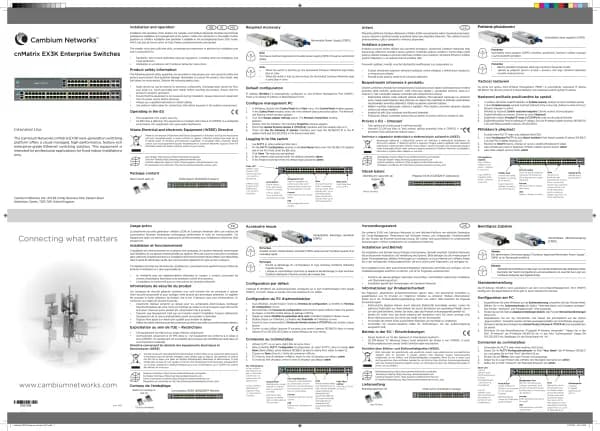Cambium Networks cnMatrix EX2028 handleiding
Handleiding
Je bekijkt pagina 113 van 320

L2 Features 113
l
Setting the trust mode to DSCP indicates that if a frame includes both 802.1p and a DSCP field,
then the DSCP field takes precedence. For non-IP packets, the ingress port's priority is used to
determine the packet's QoS properties.
l
Setting the trust mode to None indicates that the content of the frame is ignored, and the QoS
properties of the packet are assigned by using the ingress port's default priority.
The cnMatrix switch supports eight egress queues. By default, traffic marked with dot1p priority 0 is
mapped to queue 1, priority 1 to queue 2, and so on. Default queue assignment can be changed using the
“queue-map” command. A priority map can be used to send a specific class of traffic to a particular
egress queue without actually remapping the dot1p priority value. In this case, the ingress priority must
be the same as the regenerated priority.
l
A scheduler is an algorithm that decides the sequence in which frames from different egress queue
should be forwarded. Four types of scheduling algorithms are supported: strict-priority, round
robin, weighted round robin, and strict-wrr.
l
Traffic shaping is an algorithm that controls the sending of frames, by inserting delays, in such a
way that the output bandwidth conforms to a configured traffic profile. The switch uses a token
bucket shaper with CIR and CBS parameters to compare outgoing traffic.
In order for the packet to be taken out of a transmit queue and to be forwarded, a packet has to be
scheduled for transmission by the scheduler and conform to the shaper attributes. Non-conforming
packets remain queued until they will conform, even when the link is available for transmission.
Standards
l
RFC 2474 defines the differentiated services field in the IP header.
l
IEEE 802.1D incorporates the 802.1p definition of the user priority field.
l
RFC 2697 defines srTCM (single rate Three Color Marker).
l
RFC 2698 defines trTCM (two rate Three Color Marker).
Scaling Numbers
l
Up to 120 classes can be defined.
Limitations
l
Although DSCP remarking is supported with the priority-map, mapping of the traffic to the
updated queue is not supported, and all remarked priority packets will be transmitted via queue 1
only.
l
Traffic policing is not supported for classes that use priority maps.
l
Two types of meters are supported: srTCM and trTCM.
l
Four types of scheduling algorithms are supported: strict-priority, round robin, weighted round
robin, strict-wrr.
l
The WRR scheduler will not be effective if we send multiple priority traffic from the same port.
However, if multiple ports are sending traffic with unique priority traffic then the WRR scheduling
works as per the configured weights.
l
Remarking of flows under violate actions is not supported.
Bekijk gratis de handleiding van Cambium Networks cnMatrix EX2028, stel vragen en lees de antwoorden op veelvoorkomende problemen, of gebruik onze assistent om sneller informatie in de handleiding te vinden of uitleg te krijgen over specifieke functies.
Productinformatie
| Merk | Cambium Networks |
| Model | cnMatrix EX2028 |
| Categorie | Niet gecategoriseerd |
| Taal | Nederlands |
| Grootte | 32421 MB |
Caratteristiche Prodotto
| Kleur van het product | Grijs |
| Gewicht | 2770 g |
| Breedte | 440 mm |
| Diepte | 209 mm |
| Hoogte | 44 mm |


